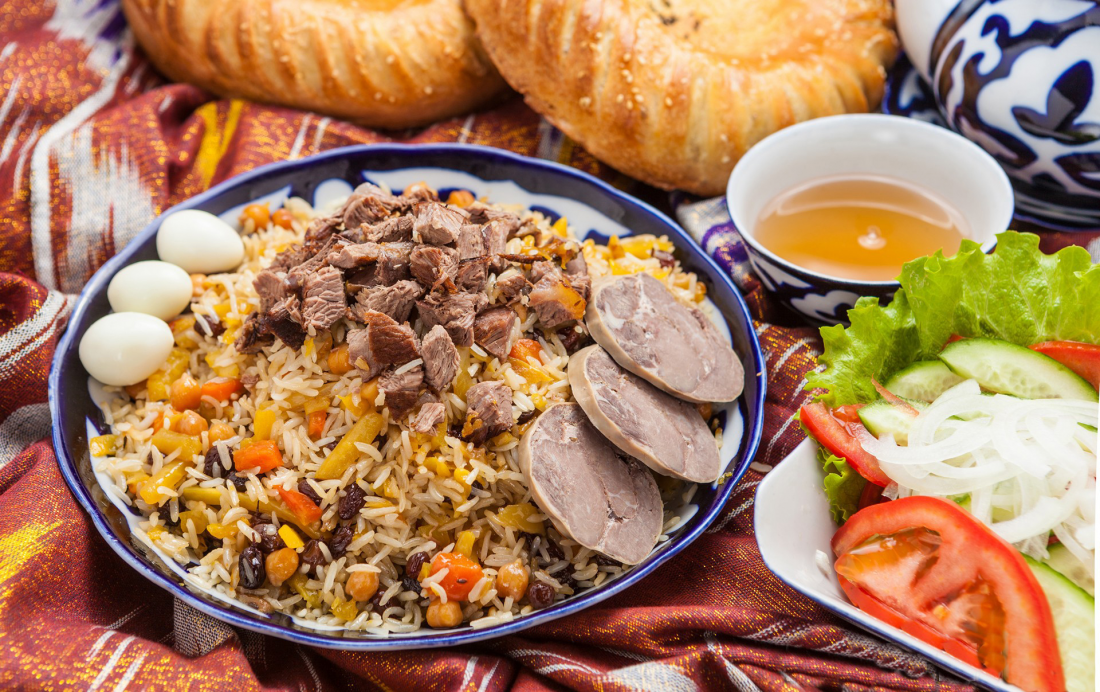Pilaf – the head of everything
In Uzbekistan, there is a saying that guests can leave the house only after they have tasted the pilaf prepared by the owners. Pilaf or, as it is called in Uzbekistan – palov, is a traditional dish that every resident of Uzbekistan should be able to prepare. This delicious food is made from very simple ingredients: rice, meat, spices, carrots and onions. Pilaf is served as an everyday and holiday dish, especially for such events as a wedding, return from a pilgrimage, birth of a child, anniversary, funeral, and as an aid to those in need. The history of pilaf goes back to the ancient times.
It is believed that a guest who has visited Uzbekistan and has not tasted real Uzbek pilaf, did not know the essence of Uzbek culture and hospitality. Uzbek pilaf is a dish of true gourmets and connoisseurs of Oriental cuisine. There are more than 100 pilaf recipes in the world, and Uzbekistan boasts of its own branded versions.
In each region of Uzbekistan pilaf is prepared according to the unique recipes. For example, in Tashkent holiday pilaf “Bayram Osh” is prepared, in Andijan the rolls from grape leaves are added to pilaf(“Kovatok palov”), in Khiva dietetic version of pilaf is cooked (“Chalov”).
However, few people know about the history of pilaf. An ancient legend tells about the origin of the word “palov”, which is associated with the name of the great Avicenna. In fact, palov is an abbreviation consisting of the capital letters of the dish's ingredients: P-piyoz-onion, A-AEZ-carrot, L-lahm – meat, O-olio – oil, V-vet – salt.
Once, the son of Bukhara ruler met a beautiful girl from a poor family. Because of class inequality, their marriage was impossible. Suffering from an unhappy love, the Prince weakened and lost interest in life and food. Then his father invites the famous physician Abu Ali Ibn Sino (Avicenna). He asked to find out the cause of this disease and cure the young heir. After examination, Ibn Sino realized that the cause of the young man’s illness was unhappy love. Ibn Sino told the ruler that there are 2 options to bring his son back to life: the first option is to marry the young man to his loved girl; the second option is to feed him one very high – calorie drug of seven ingredients called “palov”. After feeding the Prince this dish, Avicenna saw that his patient felt an unexpected surge of strength. Since that time the palov became widely used by the people and turned from the medicinal drug into a regular dish during the wide feasts and celebrations.
An old Eastern proverb says: “A good pilaf needs a hot fire, a cauldron with rice and meat, and ... love”. Indeed, there are some subtleties in the preparation of pilaf. For example, the meat should be washed only in running water, and the rice should be carefully sorted, lightly rubbing it between the palms. The oil is poured into the cauldron after it is properly heated, then the fire is reduced and meat, onions, carrots and spices are put into the cauldron – it turns out “Zirvak”. When “Zirvak” is ready, rice is poured into the cauldron. The pilaf is very tasty on the open fire.
In Uzbekistan pilaf has been an indispensable part of the ritual of family celebrations for a long time. Indeed, pilaf unites people, strengthens relationships, gives life, and supports health and immunity – it must be a reason why Avicenna has recommended it.
The culture and tradition of pilaf cooking was included into the list of UNESCO's Intangible Cultural Heritage in 2016.
Leave a comment
By logging in, you agree to the processing personal data
See also
Workhours: 9:00-18:00, Mn-Fr
For any questions
Uzbekistan


 UZB
UZB RUS
RUS JPN
JPN ARA
ARA FRA
FRA CN
CN DE
DE POR
POR ESP
ESP TUR
TUR ITA
ITA HIN
HIN MAL
MAL





A comment
Ajoyib maqola!